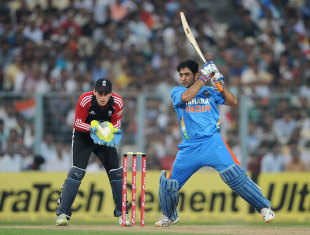India v England in India
Stephen Brenkley
One-day internationals (5): India 5, England 0
Twenty20 international (1): India 0, England 1

|
|||
|
Related Links
Series/Tournaments:
England in India T20I Match
| England in India ODI Series
|
|||
This was a tour too far for England. Barely a fortnight earlier, they had completed a home summer of almost unimpeded triumph, defeating India in all three formats. But now the boot was on the other foot - and applied with eager expertise. Everything changed: the pitches, the mood, the cricket itself. While India's conventional strengths in familiar surroundings were underlined, England's traditional weaknesses on the subcontinent were exposed.
If it was all too much for Alastair Cook's tourists, it also seemed to apply to the Indian public. The grounds for all six matches - five one-day internationals, all won by India, and the solitary Twenty20 encounter, at Kolkata, which provided belated consolation for England - were hardly three-quarters full, and sometimes much emptier. Given that it was India's first home series since they won the World Cup in April, this was a matter of concern. Several explanations were offered, from the absence of the injured Sachin Tendulkar to the imminence of Diwali, the Hindu festival of light, via the new devotion to the IPL and the indifference engendered by yet another encounter with England. The Indian board, though, displayed little inclination to abandon its policy of shoehorning cricket in wherever it could. And the 5-0 whitewash merely encouraged them to believe they were right. As for the new one-day regulations - two balls throughout the innings to be used at alternate ends and the restriction of bowling and batting powerplays to between the 16th and 40th overs - it was too soon to say if they would make a telling difference. But the enticing prospect emerged that spin would play a more incisive role.
England arrived with hopes high - a feeling encouraged by a diligent ten- day preparation period in Hyderabad, where Jonathan Bairstow's unbeaten 104 from 53 balls in the second of two warm-up games added to the sense of optimism. But the recent history of their escapades in India - they had lost 5-0 in 2008-09, and 5-1 in 2005-06 - proved a more reliable guide, and the methods of England's batsmen were again abject to the point of feeble. Their boldness, when it was displayed, betrayed panic, while their fear of leaving the crease to play spin was like a small boy's attachment to his mother's apron- strings. With Eoin Morgan unavailable after shoulder surgery, and - to the astonishment of the locals - Ian Bell ignored for all but the disastrous Kolkata one-dayer, only Kevin Pietersen exuded any presence against India's slow bowlers, Ravichandran Ashwin and Ravindra Jadeja. But even he spent much of the series failing to turn starts into something more substantial.
The bowlers were a little better and, in the case of Steven Finn, appreciably so. For some, such as Jade Dernbach, came a pertinent lesson: what works in England may not be effective against high-class batsmen elsewhere. For others, including Graeme Swann, it provided an opportunity to take stock before England's more demanding Indian assignment in 2012-13, when four Tests are scheduled in addition to several one-dayers. Finn, though, was a cut above everybody. Here was a fast bowler apparently emerging into full bloom: quick, accurate and menacing, he was able to flog life from the dead horses that double as Indian pitches. But in other areas England let themselves down. Their fielding was well below their own high standards, and their behaviour, both towards their opponents and each other, left a lot to be desired - although they privately felt the Indians had been no angels either.
There was also the matter of Swann's autobiography, published mid-tour (but serialised in two national newspapers at the start of it), in which he had criticised Pietersen's tenure as England captain. Swann insisted it had not affected their relationship - though that still begged the question of what the relationship was like in the first place. But his argument was not helped when Pietersen used the tour's final press conference, with Swann sitting alongside him, to echo Andy Flower's sentiments earlier in the trip and question the wisdom of publishing critical remarks about a current team-mate.
Oblivious to it all, India relished being back at home. They fielded a young, if not entirely inexperienced, side and were often a joy to behold. Virat Kohli was sublime throughout, but rising above all he surveyed was their remarkable captain, Mahendra Singh Dhoni, who seemed to have been playing perpetually, yet was stunningly irrepressible. Three of Dhoni's four innings proved crucial, and by the end of the one-day series he had scored 340 runs from 285 balls in six consecutive unbeaten innings against England. Only in the Twenty20 match was he finally dismissed - by a last-ball run-out. Unlike the opposition, he never seemed to break sweat, whether as keeper, batsman or captain.
Match reports for
Only T20I: India v England at Eden Gardens, Oct 29, 2011
Report |
Scorecard
Match reports for
1st ODI: India v England at Hyderabad, Oct 14, 2011
Report |
Scorecard
2nd ODI: India v England at Delhi, Oct 17, 2011
Report |
Scorecard
3rd ODI: India v England at Mohali, Oct 20, 2011
Report |
Scorecard
4th ODI: India v England at Wankhede, Oct 23, 2011
Report |
Scorecard
5th ODI: India v England at Eden Gardens, Oct 25, 2011
Report |
Scorecard

